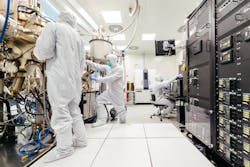Laser-based sensor could replace invasive blood analysis methods
Seeking to make noninvasive blood analysis possible, Brolis Sensor Technology (Vilnius, Lithuania) has developed a broadband laser-based sensor able to remotely sense the concentration level of main critical blood constituents such as lactate, glucose, urea, ketones, or ethanol without drawing any blood. After the technology receives regulatory approval and is integrated into compact devices, those with chronic diseases such as diabetes will no longer need to puncture their fingers numerous times a day to measure their blood glucose level.
The laser-based sensor technology operates in a spectral band that was largely unexplored in the past, explains Augustinas Vizbaras, CTO and cofounder of Brolis Sensor Technology.
Every molecule, be it lactate or glucose, is made of separate atoms—carbon, oxygen, hydrogen, and nitrogen. These atoms have unique geometrical structure. When reacting with its environment, an atom vibrates at characteristic frequencies, which are called molecular fingerprints and can be sensed with laser light.
“Because of molecular fingerprints, we can identify different molecules by measuring these vibrations,” explains Vizbaras. “What is unique about our laser is that it allows analysis from a distance. The laser light is sent to the object, where it interacts with the object and its constituents. The light is then reflected back by means of diffuse reflectance and is collected by the system. Reflected light already carries object-specific information, which is analyzed. By using this method, we can analyze remote objects of different phase—liquid, gas, or solid.”
For a laser to scan molecular fingerprints, it must have a specific kind of radiation. For this reason, the company has created a laser technology that allows to rapidly change the emission wavelength of the laser across a wide spectral band.
“When analyzing blood, or other liquid phase media, one needs a very widely tunable laser as liquids possess very broad molecular fingerprint absorption bands due to so-called collisional broadening,” adds Vizbaras. “One way to achieve this is to use a hundred lasers at the same time, but it wouldn’t be commercially viable. Our sensor is a single device that replaces the need for that many lasers.”
To this end, the company has innovated a semiconductor optical amplifier with an extremely broad gain-bandwidth. This chip is then embedded into an external cavity circuit, realized using photonic integrated circuit technology, forming an ultra-compact, all-semiconductor system-on-a-chip.
The laser developers worked in collaboration with scientists from the Lithuanian University of Health Sciences (Kaunas, Lithuania) to understand the molecules on which they should concentrate their analysis efforts. After extensive deliberations, they decided to focus on analyzing glucose, lactates, ethanol, and urea.
There are already fully functioning prototypes of the sensor, and the company aims to introduce them to the market in three or four years. Since it is a medical device, it has to go through extensive testing and comply with legal U.S. and EU regulations.
Even though the company is first implementing its sensors in the medical field, these devices will be applicable in other areas, too—for example, to see in the dark, to remotely sense gas, for on-site inspections in additive manufacturing processes, and for security applications.
“Later on, we are planning on adapting the device to measure lactates, which would be useful for everyone doing sports. The sensor could be attached to any smartwatch,” says Vizbaras. “Also, the sensors could be used to test blood alcohol levels via a fingerprint scan, or even partly replace common blood tests.”
For more information, please visit brolis-sensor.com.
Got biophotonics-related news to share with us? Contact Lee Dubay, Associate Editor, BioOptics World
Get even more news like this delivered right to your inbox
